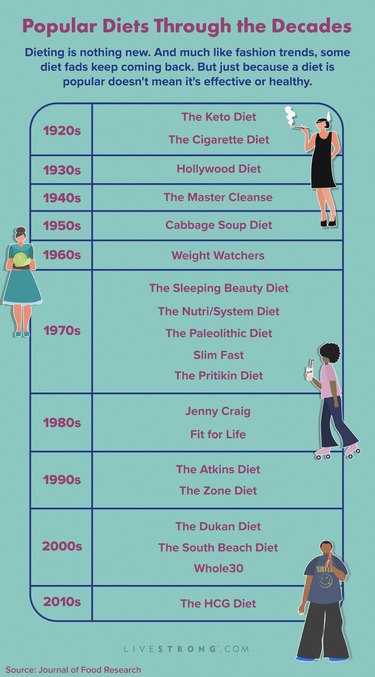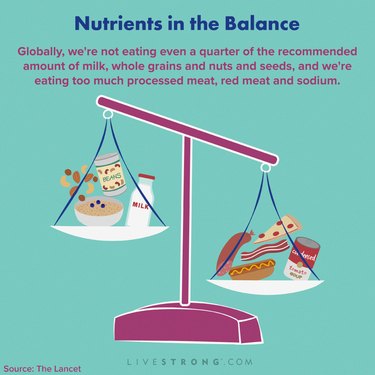
Humans have been striving to eat a healthy diet since the days of Ancient Greece and Rome. According to a 2016 paper in the Journal of Food Research, the word "diet" may even originate from the Greek word diaita, meaning mental and physical health.
But it wasn't until the Victorian era that fad diets — aka weight-loss plans that promise quick (but not necessarily long-lasting) results — really took off, per the paper. Starting in the 1800s, people began adopting diets to improve their appearances. In fact, one of the earliest and most famous dieters may have been Lord Byron, who popularized a Vinegar and Water Diet in 1820.
Video of the Day
Video of the Day
More than a century later, we're still following specific eating plans in the hopes of changing our health or appearance. Here's a closer look at today's dieting facts and statistics:
Popular Diets

Many modern-day diets were developed decades ago, only to experience a resurgence in popularity, according to the Journal of Food Research paper. Here's an abbreviated timeline of some of the most popular diets over the last 200 years.
- 2011: The HCG Diet
- 2009: Whole30
- 2003: The South Beach Diet
- 2000: The Dukan Diet
- 1995: The Zone Diet
- 1992: The Atkins Diet
- 1985: Fit for Life
- 1983: Jenny Craig
- 1979: The Pritikin Diet
- 1977: Slim Fast
- 1975: The Paleolithic Diet (this would become popular again in the 2000s, as the paleo diet)
- 1972: The Nutri/System Diet
- 1970: The Sleeping Beauty Diet
- 1961: Weight Watchers
- 1950: Cabbage Soup Diet
- 1940s: The Master Cleanse
- 1930: Hollywood Diet
- 1925: The Cigarette Diet
- 1921: The Ketogenic Diet (this would become popular again in the 2000s, as the keto diet)
- 1820: The Vinegar and Water Diet
Dieting Prevalence Globally
It's not just Americans who are following diets. Dieting is a global phenomenon, with many people revamping their eating patterns in hopes of losing weight or changing their appearance or health.
Worldwide, about 42 percent of adults are trying to lose weight, and 23 percent are trying to maintain their weight, according to a January 2017 study in Obesity Reviews.
Of the people who are trying to lose or maintain their weight:
- 20.4% count calories
- 15.9% eat diet foods or use diet products
- 12.4% track their food intake and physical activity levels
- 11.9% follow a specific diet or a fad diet
- 9.7% use meal replacements
Dieting Prevalence in the U.S.
An estimated 45 million Americans go on a diet each year, and spend $33 billion each year on weight loss products, per the Boston Medical Center.
From 2015 to 2018, nearly 1 in 5 adults in the U.S. — about 17 percent of Americans — who were over the age of 20 tried a special diet, according to the Centers for Disease Control and Prevention (CDC). Here's a closer look at the demographics:
Dieting Prevalence by Sex
A higher percentage of people assigned female at birth (AFAB) reported being on a special diet than people assigned male at birth (AMAB).
- 19% of people AFAB
- 15.1% of people AMAB
Dieting Prevalence by Race
Non-Hispanic white adults were more likely to try a special diet than people of other races in the U.S.
- 17.8% of non-Hispanic white adults
- 16.4% of Hispanic adults
- 14.7% of non-Hispanic Black adults
- 14.9% of non-Hispanic Asian adults
Dieting Prevalence by Age
Younger adults were less likely to be on a diet than older adults in the U.S.
- 13.3% of people ages 20 to 39
- 19.2% of people ages 40 to 59
- 19.3% of people ages 60 and older
Dieting Prevalence by Weight Status
People with obesity were more likely to try a special diet than people of other weight statuses.
- 23.1% of people with obesity tried a special diet
- 17.1% of people with overweight tried a special diet
- 8.3% of people who had underweight or a healthy weight tried a special diet
Diet Popularity
Most people in the U.S. report being on a low-calorie diet or other diet that will help them lose weight. Here are four of the most popular types of diets:
- 9.3% of people are on a weight-loss or low-calorie diet
- 2.3% of people are on a diet for diabetes
- 2% of people are on a low-carb diet
- 1.8% of people are on a low-fat or low-cholesterol diet
Dieting Success and Failure Rates
Much of the research about dieting focuses on weight loss — which (at least in the literature) shows a wide range of success and failure. According to the University of Pennsylvania's Weight and Eating Disorders Program%20keep%20the%20weight%20off.):
- 65% of dieters return to their pre-diet weight within three years.
- 5% of people who lose weight on a restrictive diet (such as liquid or no-carb diet) keep the weight off.
On average, people with overall healthier diets are less likely to try to lose weight than those who have unhealthier diets, according to a 2005 Gallup poll. Here's the breakdown:
- Americans who describe their diets as "very healthy" have tried to lose weight about five times in their lives.
- Americans who describe their diets as "somewhat healthy" have tried to lose weight about eight times in their lives.
- Americans who describe their diets as "not healthy" have tried to lose weight about nine times in their lives.
Dieting Consistency
People who stick to their diets throughout the week are 1.5 times more likely to maintain their weight than people who are a little more flexible, according to the July 2005 study in The American Journal of Clinical Nutrition.
Many people who diet stick to their eating plan throughout the week, though allow themselves a little flexibility on holidays and the weekends.
- 59% of dieters say they eat the same on the weekends and weekdays
- 52% of dieters are stricter during non-holiday times compared with the holidays
- 45% of dieters say they eat the same on holidays and vacations as they do during the rest of the year
- 39% of dieters are stricter on weekdays than on the weekends
- 3% of dieters eat more strictly during the holidays than during non-holidays
- 2% of dieters eat more strictly on the weekends than during the week
Dieting and Eating Disorders
According to the National Eating Disorders Association, 35 percent of "normal dieters" progress to pathological dieting and 20 to 25 percent of those individuals develop eating disorders.
Dieting and COVID-19
The COVID-19 pandemic has changed many aspects of life in the U.S. — including, according to an April 2020 Gallup Poll, some of our diets.
- 59% of Americans say their diets haven't changed during the pandemic
- 28% of Americans say their diets have gotten worse during the pandemic
- 13% of Americans say their diets have gotten better during the pandemic
Dieting and Health Stats

A poor diet — one that's either lacking in healthy foods or contains too many unhealthy foods — can increase the risk of dying at an earlier age (especially from heart disease).
Here's a closer look at how diet affects our lifespan:
- Worldwide, about 11 million people died from the
effects of a poor diet in 2017, according to a study in The Lancet, mostly by contributing to the development of cardiovascular
disease. More specifically:
- About 3 million deaths were attributed to a high intake of sodium
- About 3 million deaths were attributed to a low intake of whole grains
- About 2 million deaths were attributed to a low intake of fruits and vegetables
Globally, our diets include too little of certain recommended nutrients and too much of foods we should be limiting. Here's a closer look at where we're falling short, and where we're exceeding the mark, per The Lancet study.
Worldwide, we're eating only:
- 12% of the recommended amount of nuts and seeds
- 16% of the recommended amount of milk
- 23% of the recommended amount of whole grains
Worldwide, we're eating:
- 90% more processed meat than is recommended
- 86% more sodium than is recommended
- 18% more red meat than is recommended
- Journal of Food Research: "Fad Diets: Lifestyle Promises and Health Challenges"
- Centers for Disease Control and Prevention: "Special Diets Among Adults: United States, 2015 - 2018"
- The American Journal of Clinical Nutrition: "Long-Term Weight Loss Maintenance"
- Gallup: "Six in 10 Americans Have Attempted to Lose Weight"
- Gallup: "Few Report Impact Diet, Exercise Amid COVID-19 Crisis"
- The Lancet: "Health Effects of Dietary Risks in 195 Countries, 1990-2017: A Systematic Analysis for the Global Burden of Disease Study 2017"
- BMC: "Weight Management"
- Behavioral Nutrition: "A Connecting Between Dieting and Eating Disorders"
- Greater Good Magazine: "Please Quit Your Diet, Now"


